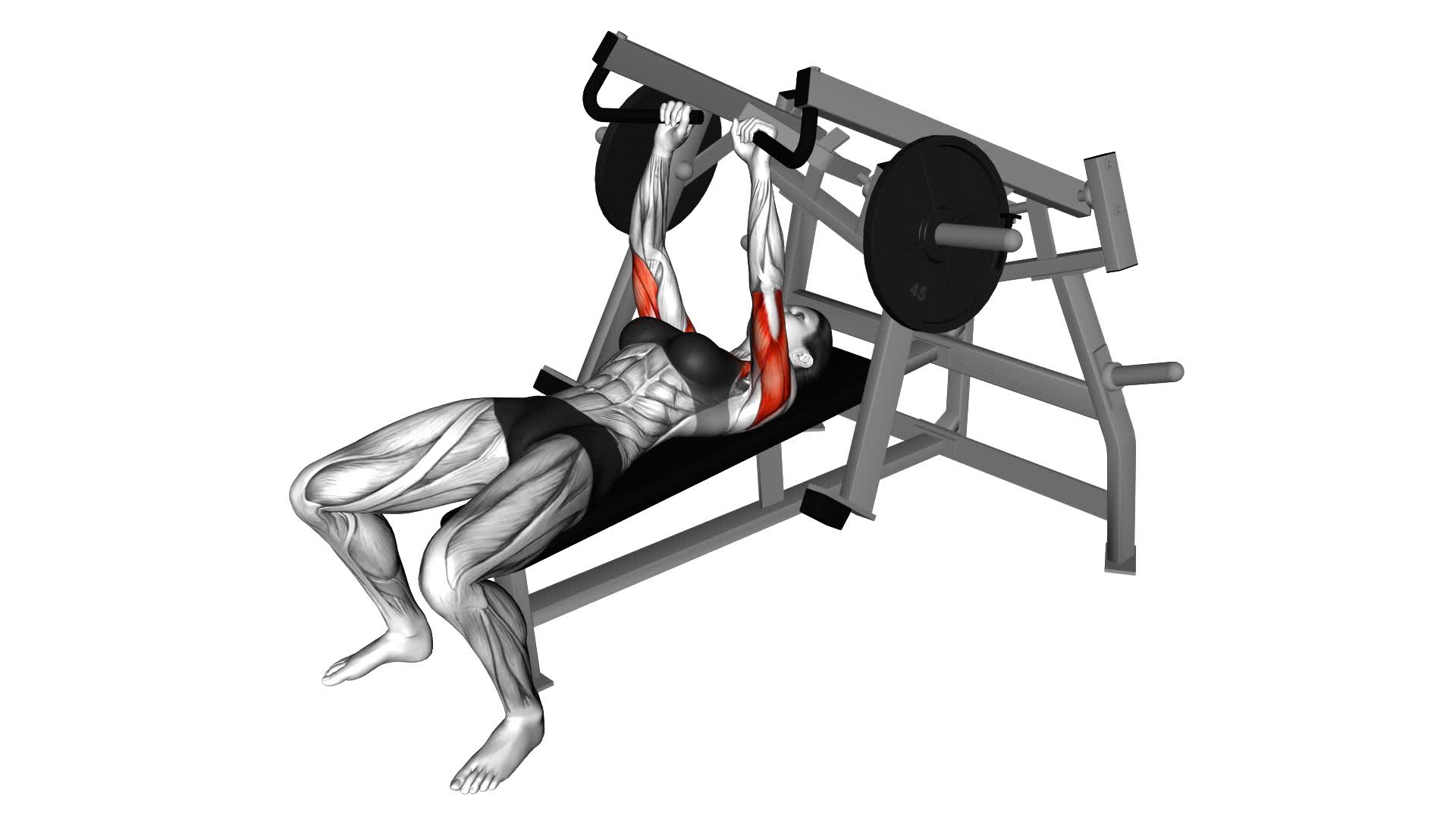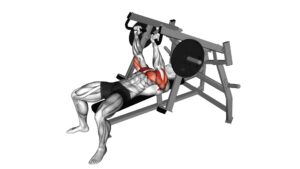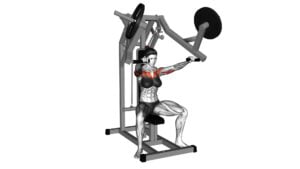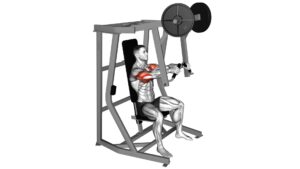Lever Lying Chest Press (Plate Loaded) (Female) – Video Exercise Guide & Tips

In this video exercise guide, you'll learn how to properly perform the lever lying chest press (plate loaded) as a female.
Watch This Exercise Video
Get ready to maximize muscle activation and avoid common mistakes with our expert tips.
Whether you're a beginner or a seasoned fitness enthusiast, we've got variations and modifications for all fitness levels.
So grab a seat and let's get started on sculpting those chest muscles!
Key Takeaways
- Maintain proper form and technique, keeping your back straight and avoiding arching it.
- Engage the targeted muscles, including the chest, shoulders, and triceps, throughout the exercise.
- Choose an appropriate weight that challenges you but allows for proper form, gradually increasing it as you progress.
- Focus on a proper breathing technique, exhaling as you push the weight away and inhaling as you lower it towards your chest.
Proper Set-Up and Machine Adjustment
To ensure proper form and maximize your workout, start by adjusting the lever lying chest press machine according to your body's needs.
First, adjust the weight stack. This will determine the level of resistance you'll be working with. Choose a weight that challenges you but still allows you to maintain proper form throughout the exercise.
Next, adjust the seat position. This is important for proper alignment and targeting of the chest muscles. Sit on the machine with your feet flat on the floor and your knees at a 90-degree angle. Adjust the seat so that the handles are in line with your mid-chest. This will ensure that you're able to fully extend your arms without straining your shoulders or compromising your form.
Once you have made these adjustments, take a moment to familiarize yourself with the machine's range of motion and hand grips. This will help you perform the exercise correctly and safely.
Remember to always start with a warm-up and consult with a fitness professional if you have any concerns or limitations.
Correct Form and Technique
Now that you have properly adjusted the lever lying chest press machine, let's focus on the correct form and technique for this exercise.
It's important to address some common misconceptions about this exercise to ensure you're performing it correctly. One common misconception is that you need to arch your back excessively, but this is incorrect. Instead, maintain a neutral spine throughout the movement to protect your lower back.
To perform the lever lying chest press with proper technique, start by gripping the handles with an overhand grip and positioning yourself on the bench with your feet flat on the floor. Engage your core and press the weight away from your chest until your arms are fully extended, keeping your elbows slightly bent to avoid locking them out. Slowly lower the weight back down to your chest, maintaining control throughout the movement.
The lever lying chest press offers several benefits, such as targeting your chest muscles, triceps, and shoulders. However, it's important to be aware of the drawbacks as well. This exercise may not be suitable for individuals with shoulder or wrist injuries, as it places stress on these joints.
Now that you understand the correct form and technique for the lever lying chest press, let's move on to discussing variations and modifications for different fitness levels.
Variations and Modifications for Different Fitness Levels
For different fitness levels, you can modify and vary the lever lying chest press exercise. Whether you're a beginner or an advanced fitness enthusiast, there are progression options and ways to customize the exercise to suit your needs.
If you're just starting out or have limited upper body strength, you can begin by using lighter weights or even just your body weight. This will allow you to focus on mastering the correct form and technique before gradually increasing the resistance.
As you progress and become stronger, you can increase the weight load or use resistance bands to make the exercise more challenging. This will help to further develop your chest muscles and improve overall strength.
Additionally, you can modify the lever lying chest press by adjusting the angle of the bench. By inclining or declining the bench, you can target different areas of your chest muscles, such as the upper or lower chest.
Remember to always listen to your body and adjust the exercise accordingly. Customizing the lever lying chest press to your fitness level will ensure that you continue to make progress and avoid injury.
Tips for Maximizing Muscle Activation
How can you effectively maximize muscle activation during the lever lying chest press exercise? Here are some tips for muscle activation that will help you get the most out of your workout and reap the benefits of the Lever Lying Chest Press.
First, make sure to maintain proper form throughout the exercise. Keep your back flat against the bench and focus on pushing through your chest muscles rather than relying on your arms or shoulders. This will ensure that you're targeting the right muscles and maximizing muscle activation.
Second, control the movement and avoid using momentum. Slow and controlled repetitions will engage your muscles more effectively and provide greater muscle activation.
Additionally, try varying your grip position. By using a wider grip, you'll engage more of your chest muscles, while a narrower grip will target your triceps more. Experiment with different grip widths to find what works best for you.
Lastly, don't forget to breathe properly. Exhale as you push the weight away from your body and inhale as you bring it back down. This will help you maintain focus and maximize muscle activation.
By implementing these tips, you can effectively maximize muscle activation during the lever lying chest press exercise.
Now, let's move on to the next section where we'll discuss safety precautions and common mistakes to avoid.
Safety Precautions and Common Mistakes to Avoid
To ensure safety and optimize results, prioritize proper technique and avoid common mistakes while performing the lever lying chest press exercise. This exercise can be highly effective in targeting the chest muscles, but it's important to take precautions to prevent injuries and get the most out of your workout.
First and foremost, always warm up before starting any exercise routine. This will help prepare your muscles for the workout and reduce the risk of strains or pulls. Additionally, it's crucial to use the appropriate amount of weight for your fitness level. Using too heavy of a weight can lead to improper form and potential injuries.
Spotting techniques are also essential for safety during the lever lying chest press exercise. If you're lifting heavy weights, it's recommended to have a spotter to assist you. The spotter should stand behind the bench and be ready to help if you struggle to complete a repetition. They can provide support and guide the weight back to the starting position if needed.
Lastly, be mindful of your form throughout the exercise. Keep your back flat against the bench, engage your core, and maintain a controlled and steady movement. Avoid arching your back or using momentum to lift the weight, as this can put unnecessary strain on your muscles and increase the risk of injury.
Frequently Asked Questions
How Many Repetitions and Sets Should I Do When Performing the Lever Lying Chest Press?
When performing the lever lying chest press, it's important to determine the number of repetitions and sets based on your fitness goals and abilities.
Start with a weight that challenges you, but allows you to maintain proper form.
Generally, it's recommended to perform 8-12 repetitions for 2-3 sets to build strength and muscle endurance.
Adjust the weight and repetitions as needed to continue progressing in your fitness journey.
What Is the Recommended Weight to Use for the Lever Lying Chest Press Exercise?
To determine the recommended weight for the lever lying chest press exercise, take into account your fitness level and desired intensity. Start with a weight that challenges you but allows you to maintain proper form throughout the exercise.
Gradually increase the weight as your strength improves. Remember, maintaining proper form is crucial to avoid injury and maximize results. Experiment with different weights to find what works best for you.
Can I Use This Exercise to Target Other Muscle Groups Besides the Chest?
Yes, you can use the Lever Lying Chest Press exercise to target other muscle groups besides the chest. By adjusting your hand positioning and grip, you can engage different muscles such as the triceps, shoulders, and upper back.
Additionally, you can incorporate variations of the Lever Lying Chest Press, like incline or decline presses, to further target specific muscle groups. These variations can help you achieve a more well-rounded and effective workout.
Is It Necessary to Warm up Before Performing the Lever Lying Chest Press?
Before performing the lever lying chest press, it's important to warm up. Warming up has several benefits, such as increasing blood flow to the muscles, improving flexibility, and reducing the risk of injury. It prepares your body for the exercise and enhances your performance.
Additionally, there are variations of the lever lying chest press that target different muscle groups, such as incline and decline presses. These variations can provide a more comprehensive workout for your upper body.
Can I Perform the Lever Lying Chest Press Exercise if I Have a Pre-Existing Shoulder Injury?
If you have a pre-existing shoulder injury, it's important to consider alternative exercises or modifications for the lever lying chest press. This exercise puts strain on the shoulders, so it may not be suitable for you.
It's best to consult with a fitness professional or physical therapist who can provide guidance on exercises that won't exacerbate your shoulder injury. Safety and proper form should always be prioritized during workouts to prevent further injury.
Conclusion
In conclusion, the lever lying chest press is a great exercise for targeting the chest muscles. By properly adjusting the machine and maintaining correct form and technique, individuals of different fitness levels can benefit from this exercise.
Maximizing muscle activation can be achieved through variations and modifications, while also ensuring safety precautions are followed. By avoiding common mistakes, individuals can effectively strengthen their chest muscles and improve their overall fitness.

Author
Years ago, the spark of my life’s passion ignited in my mind the moment I stepped into the local gym for the first time. The inaugural bead of perspiration, the initial endeavor, the very first surge of endorphins, and a sense of pride that washed over me post-workout marked the beginning of my deep-seated interest in strength sports, fitness, and sports nutrition. This very curiosity blossomed rapidly into a profound fascination, propelling me to earn a Master’s degree in Physical Education from the Academy of Physical Education in Krakow, followed by a Sports Manager diploma from the Jagiellonian University. My journey of growth led me to gain more specialized qualifications, such as being a certified personal trainer with a focus on sports dietetics, a lifeguard, and an instructor for wellness and corrective gymnastics. Theoretical knowledge paired seamlessly with practical experience, reinforcing my belief that the transformation of individuals under my guidance was also a reflection of my personal growth. This belief holds true even today. Each day, I strive to push the boundaries and explore new realms. These realms gently elevate me to greater heights. The unique combination of passion for my field and the continuous quest for growth fuels my drive to break new ground.







